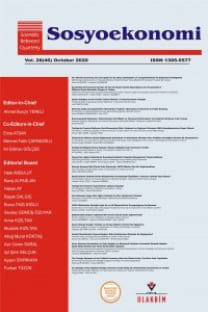Oil Price Fluctuations and Changing Comparative Advantage
This paper attempts to quantify the effects of oil price fluctuations on revealed comparative advantage (RCA) for 36 manufacturing commodities of 167 countries over a 16-year period from 1990 to 2005. Using Zellner’s (1962) seemingly unrelated regression (SURE) model, the negative effects of oil price fluctuations on RCA vary according to objectives and model specification. Oil price fluctuations negatively affect manufacturing commodities’ RCA in 1997-2005 more than in 1990-1996 periods. The paper also found that oil price fluctuations negatively affect middle-income economies and net oil-exporting countries’ RCA more than high-income economies and net oil-importing countries.
Anahtar Kelimeler:
-
Oil Price Fluctuations and Changing Comparative Advantage
This paper attempts to quantify the effects of oil price fluctuations on revealed comparative advantage (RCA) for 36 manufacturing commodities of 167 countries over a 16-year period from 1990 to 2005. Using Zellner’s (1962) seemingly unrelated regression (SURE) model, the negative effects of oil price fluctuations on RCA vary according to objectives and model specification. Oil price fluctuations negatively affect manufacturing commodities’ RCA in 1997-2005 more than in 1990-1996 periods. The paper also found that oil price fluctuations negatively affect middle-income economies and net oil-exporting countries’ RCA more than high-income economies and net oil-importing countries.
Keywords:
-,
___
- Balassa, B. (1965), “Trade Liberalization and Revealed Comparative Advantage”, The Manchester School of Economic and Social Studies, 33(2), 99-124.
- Balassa, B. A. (1977), “Revealed” Comparative Advantage: Johns Hopkins University, Dept. of Political Economy.
- Berument, M.H., N.B. Ceylan & N. Dogan (2005), “The Impact of Oil Price Shocks on the Economic Growth of Selected MENA Countries”, The Energy Journal, 31(1).
- Bhagwati, J. (1998), The Global Age: From Skeptical South to a Fearful North in A Stream of Windows–Unsettling Reflections on Trade, Immigration, and Democracy: Cambridge, Massachusetts, The MIT Press.
- Burbridge, J. & A. Harrison (1984), “Testing For the Effects of Oil--Price Rises Using Vector Autoregressions”, International Economic Review, 25(2).
- Driffield, N. & M. Munday (2000), “Industrial Performance, Agglomeration, and Foreign Manufacturing Investment in the UK”, Journal of International Business Studies, 31(1).
- Dunning, J.H. (1993), Multinational enterprises and the global economy: Addison-Wesley Reading, Mass.
- Felicitas Nowak-Lehmann, D., V. Sebastian & M.Z. Immaculada (2007), Competitiveness - A Comparison of China and Mexico: CESifo GmbH.
- Gisser, M. & T.H. Goodwin (1986), “Crude Oil and the Macroeconomy: Tests of Some Popular Notions”, Journal of Money, Credit & Banking, 18(1), 95-103.
- Hall, R.E. & C.I. Jones (1999), “Why Do Some Countries Produce So Much More Output per Worker than Others?*”. Quarterly Journal of Economics, 114(1), 83-116.
- Hamilton, J.D. (1983), “Oil and the Macroeconomy since World War II”, Journal of Political Economy, 91(2), 248.
- Hamilton, J.D. (1988), “A Neoclassical Model of Unemployment and the Business Cycle”, The Journal of Political Economy, 96(3), 593-617.
- Hunt, B., P. Isard & D. Laxton (2001), “The Macroeconomic Effects of Higher Oil Prices”, IMF Working Paper, (Vol. WP/01/14).
- International Energy Agency (2004), Analysis of the Impact of High Oil Prices on the Global Economy.
- Krause, L.B. (1987), “The Structure of Trade in Manufactured Goods in the East and Southeast Asian Region: Trade and Structural Change in Pacific Asia.
- Lee, K., S. Ni & R.A. Ratti (1995), “Oil shocks and the macroeconomy: The role of price variability”, The Energy Journal, 16(4), 39-56.
- Lilien, D.M. (1982), “Sectoral Shifts and Cyclical Unemployment”, Journal of Political Economy, 90(4), 777-793.
- Mork, K. A. (1989), “Oil and the Macroeconomy When Prices Go Up and Down: An Extension of Hamilton's Results”, Journal of Political Economy, 97(3).
- Rasche, R.H., & J.A. Tatom (1977), “Energy Resources and Potential GNP”, Federal Reserve Bank of St. Louis Review, 59(6), 10-24.
- Rasche, R.H., & J.A. Tatom (1981), “Energy Price Shocks, Aggregate Supply and Monetary Policy: The Theory and International Evidence”, Carnegie-Rochester Conference Series on Public Policy, 14, 9-93.
- Pindyck, R.S. & J.J. Rotemberg (1983), “Dynamic Factor Demands and the Effects of Energy Price Shocks”, The American Economic Review, 73(5), 1066-1079.
- Voon, T., Centre for Asian Pacific, S. & Faculty of Social, S. (1996), Export Competitiveness of China and ASEAN in the US Market: Faculty of Social Sciences, Lingnan College Hong Kong.
- Zellner, A. (1962), “An Efficient Method of Estimating Seemingly Unrelated Regressions and Tests for Aggregation Bias”, Journal of the American Statistical Association, 57(298), 348-368.
- ISSN: 1305-5577
- Yayın Aralığı: Yılda 4 Sayı
- Başlangıç: 2005
- Yayıncı: Sosyoekonomi Derneği
Sayıdaki Diğer Makaleler
Kamu Kurumlarında e-İşe Alım İçin İlk Adım: Gazete İlanlarından e-İlan'a Geçiş
Hakan DULKADİROĞLU, Mehmet ALTUNDEMİR
Vakıf Üniversitelerinde Ücretler
Türkiye’de kredi kartları piyasasına yönelik kamu müdahaleleri
Ahmet Burçin YERELİ, Ali Fuat KOÇ
Türkiye’de Döviz Kuru Hareketlerinin İç Fiyatlara (İthalat Fiyatları, ÜFE ve TÜFE) Geçişi
Ödemeler Bilançosu Aşamaları Hipotezi: Parametrik Olmayan Bir Yaklaşım
Mülkiyet Hakları ile Ekonomik Büyüme Arasındaki İlişki: AB Ülkeleri Üzerine Ampirik Bir İnceleme
Avrupa Birliği Üyesi Ülkelerde ve Türkiye'de Katma Değer Vergisi: Yakınsama Gerçekleşiyor Mu?
